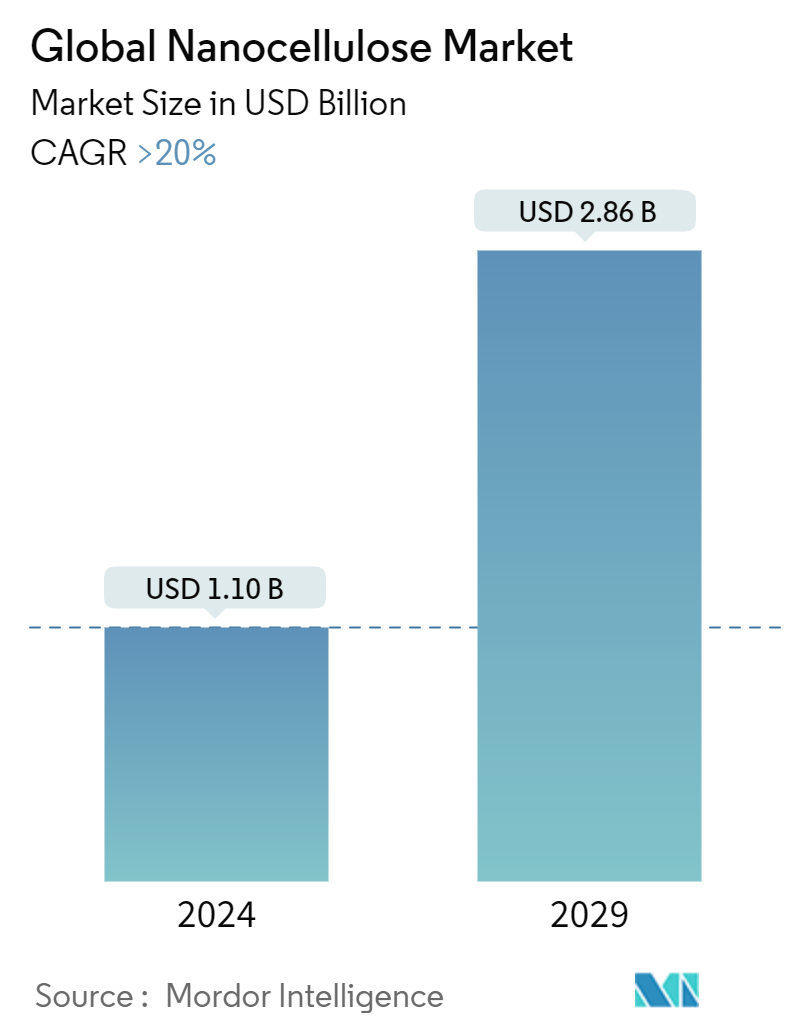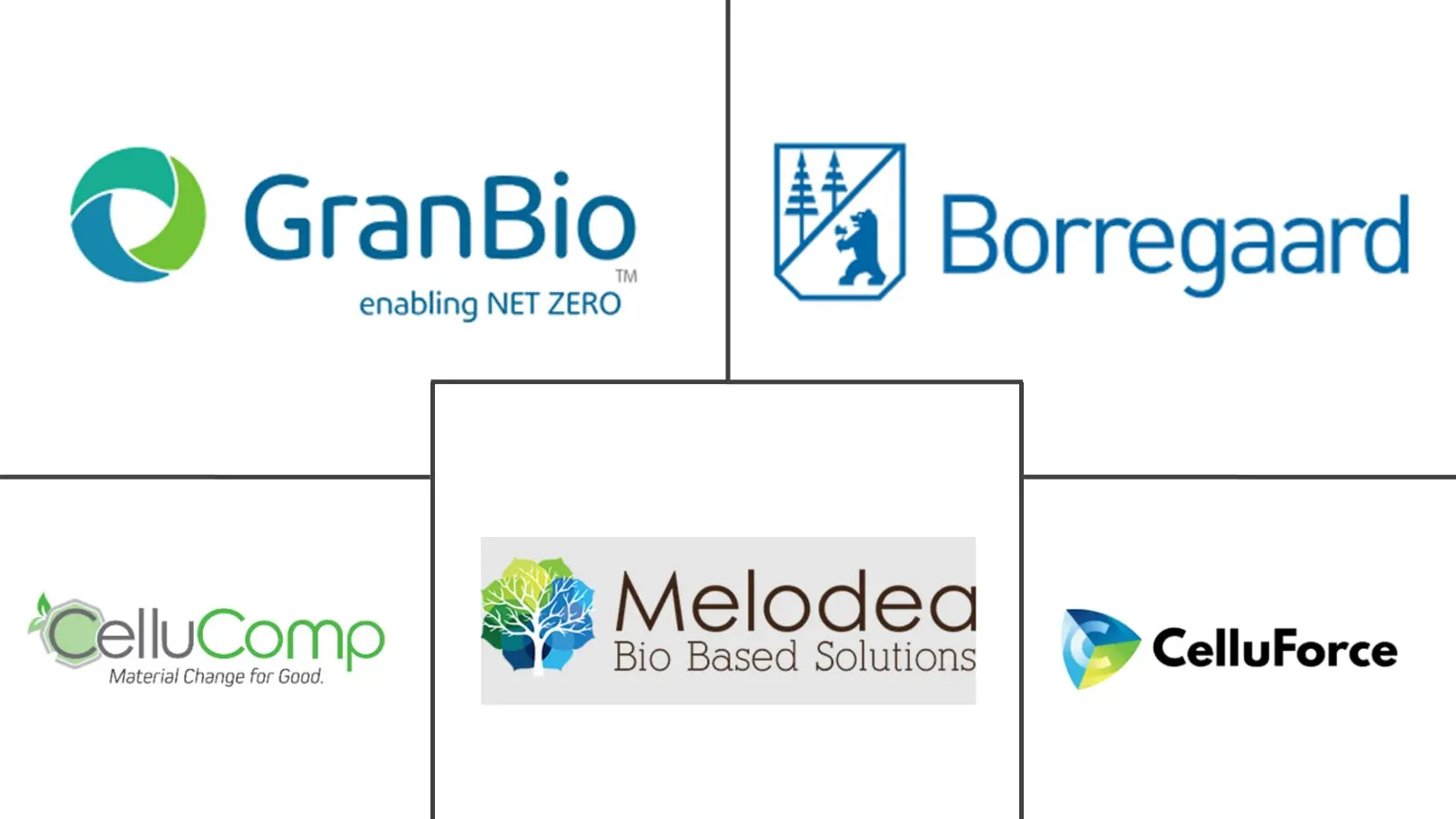Market Size of Global Nanocellulose Industry

| Study Period | 2019 - 2029 |
| Market Size (2024) | USD 1.10 Billion |
| Market Size (2029) | USD 2.86 Billion |
| CAGR (2024 - 2029) | 20.00 % |
| Fastest Growing Market | Asia Pacific |
| Largest Market | North America |
Major Players
*Disclaimer: Major Players sorted in no particular order |
Nanocellulose Market Analysis
The Global Nanocellulose Market size is estimated at USD 1.10 billion in 2024, and is expected to reach USD 2.86 billion by 2029, growing at a CAGR of greater than 20% during the forecast period (2024-2029).
With the rising demand from oil and gas, the textile segment is witnessing an increased demand from various application segments, owing to the growing utilization of multiple products.
- Over the short term, the increasing adoption of flexible packaging and the superior properties of nanocellulose are expected to drive the growth of the studied market.
- However, a shortage of consumer awareness and economic barriers are expected to hinder the market's growth.
- Increasing innovation activities, research and development investments, and capacity expansions by manufacturers to capitalize on the broad applicability are expected to unveil new opportunities for the market studied.
- North America dominated the market across the world with the most substantial consumption of nanocellulose.
Nanocellulose Industry Segmentation
Nanocellulose is a light solid substance obtained from plant matter and consists of nanosized cellulose fibers. Nanocellulose has excellent barrier properties, as nanofibers form a dense network held together by inter-fibril solid bonds.
The nanocellulose market is segmented by end-user industry, product type, and geography. By end-user industry, the market is segmented into paper processing, paints and coatings, oil and gas, food and beverage, composites, pharmaceutical and cosmetics, and other end-user industries (packaging, textiles, etc.). By product type, the market is segmented into nanofibrillated cellulose (NFC), nanocrystalline cellulose (NCC), bacterial cellulose, microfibrillated cellulose (MFC), and other product types (tempo oxidized nanocellulose, cellulose nanocomposites, etc.). The report also covers the market sizes and forecasts for the nano cellulose market in 27 countries across major regions. For each segment, the market sizing and forecasts have been done based on revenue (USD).
| End-user Industry | |
| Paper Processing | |
| Paints and Coatings | |
| Oil and Gas | |
| Food and Beverage | |
| Composites | |
| Pharmaceuticals and Cosmetics | |
| Other End-user Industries |
| Product Type | |
| Nanofibrillated Cellulose (NFC) | |
| Nanocrystalline Cellulose (NCC) | |
| Bacterial Cellulose | |
| Microfibrillated Cellulose (MFC) | |
| Other Product Types |
| Geography | |||||||||||
| |||||||||||
| |||||||||||
| |||||||||||
| |||||||||||
|
Global Nanocellulose Market Size Summary
The nanocellulose market is poised for significant growth, driven by its increasing application across various industries such as oil and gas, textiles, and flexible packaging. The material's superior properties, including biodegradability and non-toxicity, make it an attractive alternative to traditional plastics, particularly in the composites segment. This shift is supported by government initiatives and investments aimed at promoting sustainable materials, which are expected to bolster the demand for nanocellulose in packaging and biodegradable plastics. The automotive industry also benefits from nanocellulose composites, which enhance the lightweight and mechanical properties of vehicle components, aligning with the global push towards electric vehicles. Despite challenges like limited consumer awareness and economic barriers, ongoing innovation and research are likely to open new avenues for market expansion.
North America currently leads the global nanocellulose market, with substantial consumption driven by infrastructure projects and the renovation of commercial buildings. The region's diverse industries, including food and beverage, oil and gas, and construction, are anticipated to further fuel market growth. In the food sector, nanocellulose serves as a thickening agent and stabilizer, offering benefits such as reduced fat content and extended shelf life. The paper industry also leverages nanocellulose to enhance paper properties, contributing to its renewable and sustainable appeal. The market is characterized by a consolidated landscape with key players like CelluForce, GranBio, and Borregaard, who are actively expanding their product portfolios to meet the rising demand.
Global Nanocellulose Market Size - Table of Contents
-
1. MARKET DYNAMICS
-
1.1 Drivers
-
1.1.1 Superior Properties of Nanocellulose
-
1.1.2 Increasing Adoption of Flexible Packaging Aids
-
1.1.3 Other Drivers
-
-
1.2 Restraints
-
1.2.1 Economic Barriers Hindering Market Growth
-
1.2.2 Growing Consumer Awareness
-
-
1.3 Industry Value Chain Analysis
-
1.4 Porter's Five Forces Analysis
-
1.4.1 Bargaining Power of Suppliers
-
1.4.2 Bargaining Power of Consumers
-
1.4.3 Threat of New Entrants
-
1.4.4 Threat of Substitute Products and Services
-
1.4.5 Degree of Competition
-
-
-
2. MARKET SEGMENTATION (Market Size in Value)
-
2.1 End-user Industry
-
2.1.1 Paper Processing
-
2.1.2 Paints and Coatings
-
2.1.3 Oil and Gas
-
2.1.4 Food and Beverage
-
2.1.5 Composites
-
2.1.6 Pharmaceuticals and Cosmetics
-
2.1.7 Other End-user Industries
-
-
2.2 Product Type
-
2.2.1 Nanofibrillated Cellulose (NFC)
-
2.2.2 Nanocrystalline Cellulose (NCC)
-
2.2.3 Bacterial Cellulose
-
2.2.4 Microfibrillated Cellulose (MFC)
-
2.2.5 Other Product Types
-
-
2.3 Geography
-
2.3.1 Asia-Pacific
-
2.3.1.1 China
-
2.3.1.2 India
-
2.3.1.3 Japan
-
2.3.1.4 South Korea
-
2.3.1.5 Malaysia
-
2.3.1.6 Thailand
-
2.3.1.7 Indonesia
-
2.3.1.8 Vietnam
-
2.3.1.9 Rest of Asia-Pacific
-
-
2.3.2 North America
-
2.3.2.1 United States
-
2.3.2.2 Canada
-
2.3.2.3 Mexico
-
-
2.3.3 Europe
-
2.3.3.1 Germany
-
2.3.3.2 United Kingdom
-
2.3.3.3 France
-
2.3.3.4 Italy
-
2.3.3.5 Spain
-
2.3.3.6 NORDIC Countries
-
2.3.3.7 Turkey
-
2.3.3.8 Russia
-
2.3.3.9 Rest of Europe
-
-
2.3.4 South America
-
2.3.4.1 Brazil
-
2.3.4.2 Argentina
-
2.3.4.3 Colombia
-
2.3.4.4 Rest of South America
-
-
2.3.5 Middle East and Africa
-
2.3.5.1 Saudi Arabia
-
2.3.5.2 South Africa
-
2.3.5.3 Nigeria
-
2.3.5.4 Qatar
-
2.3.5.5 Egypt
-
2.3.5.6 United Arab Emirates
-
2.3.5.7 Rest of Middle East and Africa
-
-
-
Global Nanocellulose Market Size FAQs
How big is the Global Nanocellulose Market?
The Global Nanocellulose Market size is expected to reach USD 1.10 billion in 2024 and grow at a CAGR of greater than 20% to reach USD 2.86 billion by 2029.
What is the current Global Nanocellulose Market size?
In 2024, the Global Nanocellulose Market size is expected to reach USD 1.10 billion.

